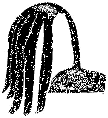







|
|
Featured Sea Vegetable -
Kombu
(Laminaria Digitata & Setchelli)
|
 Going into the ocean, into the channels, sometimes following the underwater
rock path out even deeper, at the deepest of minus tides, I go in the early
morning, diver's booties and my wetsuit giving me protection from the cold
ocean and sharp rocks, to seek and find the treasure: the large, deep-growing,
rarely exposed kombu. One of the most challenging sea vegetable to
harvest because of its deep location, mass, and slippery surface, kombu
is also one of the most rewarding. --E.L.
Going into the ocean, into the channels, sometimes following the underwater
rock path out even deeper, at the deepest of minus tides, I go in the early
morning, diver's booties and my wetsuit giving me protection from the cold
ocean and sharp rocks, to seek and find the treasure: the large, deep-growing,
rarely exposed kombu. One of the most challenging sea vegetable to
harvest because of its deep location, mass, and slippery surface, kombu
is also one of the most rewarding. --E.L.
Kombu isn't in our first forager's guide, because we learned
most of what we know about sea vegetables by trial and error, and Laminaria
setchelli didn't look very appetizing to me. Most of the thick,
brown bladed algae of the Laminaria genus, called kombu by the Japanese,
look about as palatable as a razor strap.
Now kombu broth is one of our favorite soup stocks, and we rarely
cook a pot of beans or rice without adding a few strips of this thick,
black sea vegetable. The great nutritional and healing values of
kombu, and its history as a royal Japanese delicacy, are described in our Sea Vegetable
Gourmet Cookbook and Foragers Guide.
Several species of Laminaria are dried and eaten as kombu.
I'll focus here on the Atlantic Coast species Laminaria digitata,
and its close Pacific relative, Laminaria setchelli, an excellent
kombu well distributed in both the Pacific Northwest and the North Atlantic.
Kombu grows in the lowest inter tidal zone, so a wetsuit is
helpful in harvesting even at lowest tides. Its stout, woody stipe
tends to stand up vertically, so the thick brown blade droops down from
it at minus tide. The blade issues from the stipe and becomes up
to a foot and a half to two feet wide, and perhaps four feet long.
The young blade is oval, but soon is split into several divisions, so it
looks a bit like a thick fan, and waves back and forth in the surf in a
way suggesting one of its folk names, "horsetail kelp."
Harvest kombu by slicing the blade just above where the 'fingers'
are divided, leaving some of the blade attached to the stipe. Although
not as gloriously regenerative as Alaria, digitata may grow a new blade
during the same season, and the stipe probably will put out a new blade
in the next season. Some harvesters cut only the 'fingers' from the
plant, but this makes drying a large harvest difficult, because each blade
must then be spread on screens to dry.
I dry most kombu blades by hooking the crotch of their splits
over a line. Kombu is a slippery creature, and oozes a thick, clear
gel as it warms. Babs notes that this gel is a very soothing when rubbed
on the skin. It has a consistancy similar to the aloe vera gel.
To get a jet-black dried kombu, dry the blades as rapidly as
possible. Kombu dried slowly will 'sweat' a fine, sweet sugar called
mannitol, giving it a white powdered look.
Kombu
Nutritional & Healing Notes
Kombu
Recipes
|
![]()
 Going into the ocean, into the channels, sometimes following the underwater
rock path out even deeper, at the deepest of minus tides, I go in the early
morning, diver's booties and my wetsuit giving me protection from the cold
ocean and sharp rocks, to seek and find the treasure: the large, deep-growing,
rarely exposed kombu. One of the most challenging sea vegetable to
harvest because of its deep location, mass, and slippery surface, kombu
is also one of the most rewarding. --E.L.
Going into the ocean, into the channels, sometimes following the underwater
rock path out even deeper, at the deepest of minus tides, I go in the early
morning, diver's booties and my wetsuit giving me protection from the cold
ocean and sharp rocks, to seek and find the treasure: the large, deep-growing,
rarely exposed kombu. One of the most challenging sea vegetable to
harvest because of its deep location, mass, and slippery surface, kombu
is also one of the most rewarding. --E.L.